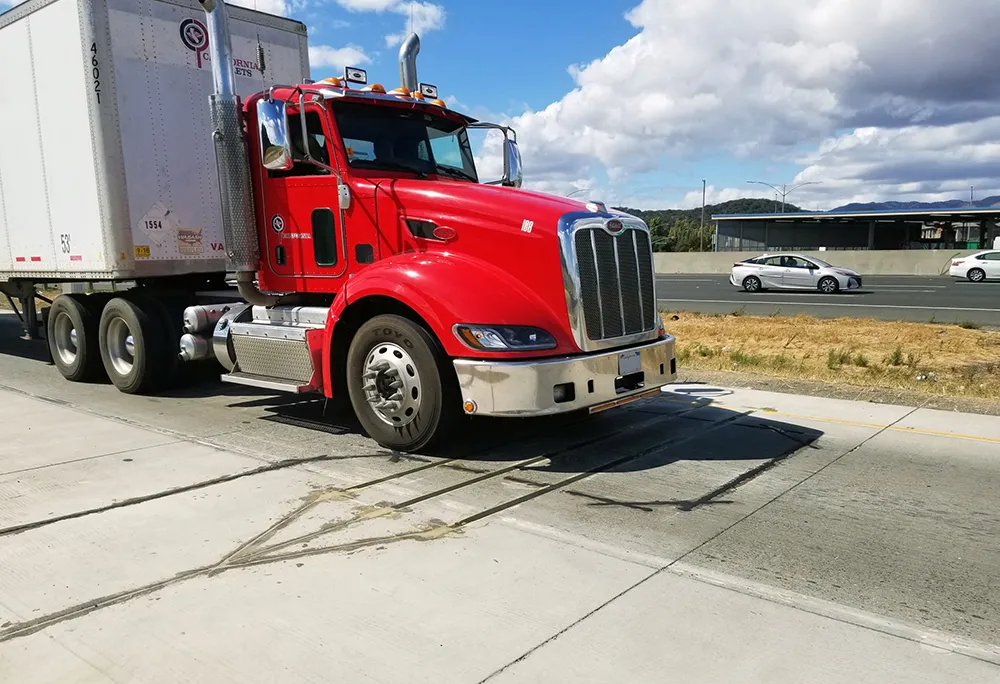
Commercial vehicles in New Brunswick are subject to enforcement of the province's weights and dimensions legislation and the National Safety Code (NSC) requirements through inspections on-road and at commercial vehicle inspection facilities.
Project:
Commercial Vehicle Operations - Motor Carrier Profile for New Brunswick, Canada
Cost:
$1,125,000 (Initial Capital Cost)
ROI:
Net Present Value: $726,000
Benefit/Cost: 1.5
Benefits:
Increases in public agency efficiency:
Savings in resources and staffing levels over the years as required by increasing truck traffic volumes;
Increased ability to monitor performance of commercial vehicle fleet;
Operational efficiency of commercial vehicle inspection facilities.
Road user benefits:
Decrease in number of inspections for some carriers;
Time savings and increased customer satisfaction.In order to keep commercial vehicle operations safe, the Province has set an enforcement level target of one vehicle stopped per shift-hour. With the growth of truck traffic volumes expected for the next few years, however, the percentage of commercial vehicle traffic stopped at the inspection facilities will naturally decrease and safety levels may potentially deteriorate.
Benefits
Commercial vehicle safety inspections take place to prevent crashes and, therefore, fatalities, injuries and property damage. A clear relationship exists between the number of inspections and prevented crashes. It is reasonable then to assume that in order not to allow a deterioration of provincial safety levels current commercial vehicle inspection and enforcement targets in New Brunswick should be maintained in the future. Through the implementation of technology under the MCP a more focused safety enforcement system can be put in place achieving the same highway safety levels that can be gained through institutional measures such as changing schedules, extending staff hours or adding staff or inspection facilities. Economic analysis
The MCP project is primarily oriented to the CVO enforcement staff providing significant improvements in their ability to monitor the safety performance of the commercial vehicle fleet and in the operational efficiency of the roadside commercial vehicle inspection facilities. This will be accomplished through the access and use of up-to-date motor carrier profile, safety and recent contact data by Commercial Vehicle Enforcement (CVE) officers during the inspection processes. Since it is reasonable to assume that enforcement levels in New Brunswick must be maintained in the future, the relevant comparison for the purpose of the project evaluation is between an increase in resources and staff versus the use of technology for alternative inspection strategies.
Thus, while benefits of this element are ultimately related to safety they also make a direct contribution in the area of agency efficiency.
The quantification of benefits and the benefit:cost analysis for the Motor Carrier Profile project for New Brunswick considers a base case defined as a continuation of the current enforcement practices - that is, increasing resources over the years as required by increasing truck traffic volumes in order to meet current enforcement levels and targets, and an alternative case defined as the implementation of the proposed Motor Carrier Profile system.
The economic analysis included a quantification of the Net Present Value (NPV) and the Benefit:Cost (B:C) ratio.The NPV is the present-day value of benefits (savings in annual enforcement costs) minus the present-day value of costs (capital costs). An NPV greater than zero means that the net benefits of the project exceed the project's investment costs and that it is therefore economically efficient.
The B:C is calculated by dividing the present-day value of benefits (annual savings) by the present-day value of investment costs. A ratio of greater than one means that the project is worthwhile.
The Motor Carrier Profile element of the CVO programme, both the NPV and the B:C, indicate that the project is economically viable and a good investment for the Province.
As stated before, a number of assumptions have been made, including truck traffic growth rates and cost estimates. The most important underlying assumption is perhaps related to the fact that fewer but more focused inspections should result in provincial safety levels that are similar, or better, than existing ones under current enforcement practices. Preliminary indications and stakeholder surveys appear to suggest so.
Quantified benefits for this project relate to increases in public agency efficiency. Due to the nature of current (and future) commercial vehicle enforcement operations in New Brunswick no delays are or will be experienced at commercial vehicle inspection facilities. However, the implementation of the MCP should eventually result in a decrease in the number of inspections for a carrier, saving time and increasing customer satisfaction. These benefits, however, were not considered for this sample case.
Should New Brunswick decide to proceed with the proposed MCP system, future performance monitoring should be put in place to confirm the validity of the assumptions made and provide lessons for future similar undertakings.
RSS










